Analysing TCE and RBV in Firms' Internationalising Strategies
VerifiedAdded on 2023/05/29
|10
|2791
|425
Essay
AI Summary
This essay critically assesses Transaction Cost Economics (TCE) and Resource-Based View (RBV) theories, examining their usefulness in explaining firms' internationalising strategies. It highlights the differences and debates surrounding these two organisational theories, noting TCE's focus on preventing negative outcomes through efficient transactions and RBV's emphasis on exploiting positive opportunities from resource configurations. The essay uses the example of a Chinese fishery community to illustrate TCE and Toyota to explain RBV, analysing how each framework informs strategic decisions. The essay concludes that while RBV is valuable for sustainable development through internal capabilities, it is essential to consider external factors for a comprehensive international strategy. Desklib provides resources for students, including past papers and solved assignments related to international business strategy.
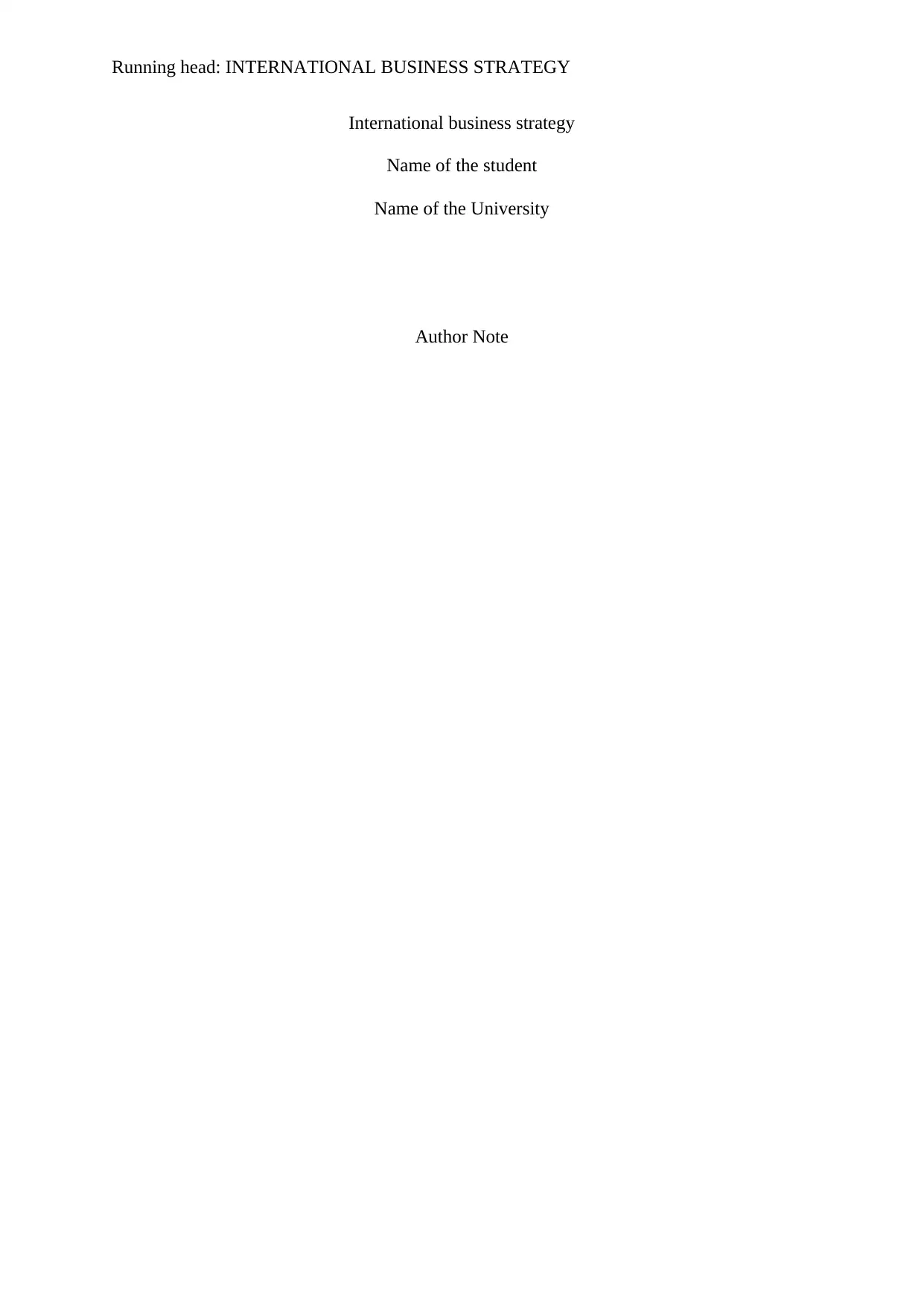
Running head: INTERNATIONAL BUSINESS STRATEGY
International business strategy
Name of the student
Name of the University
Author Note
International business strategy
Name of the student
Name of the University
Author Note
Paraphrase This Document
Need a fresh take? Get an instant paraphrase of this document with our AI Paraphraser
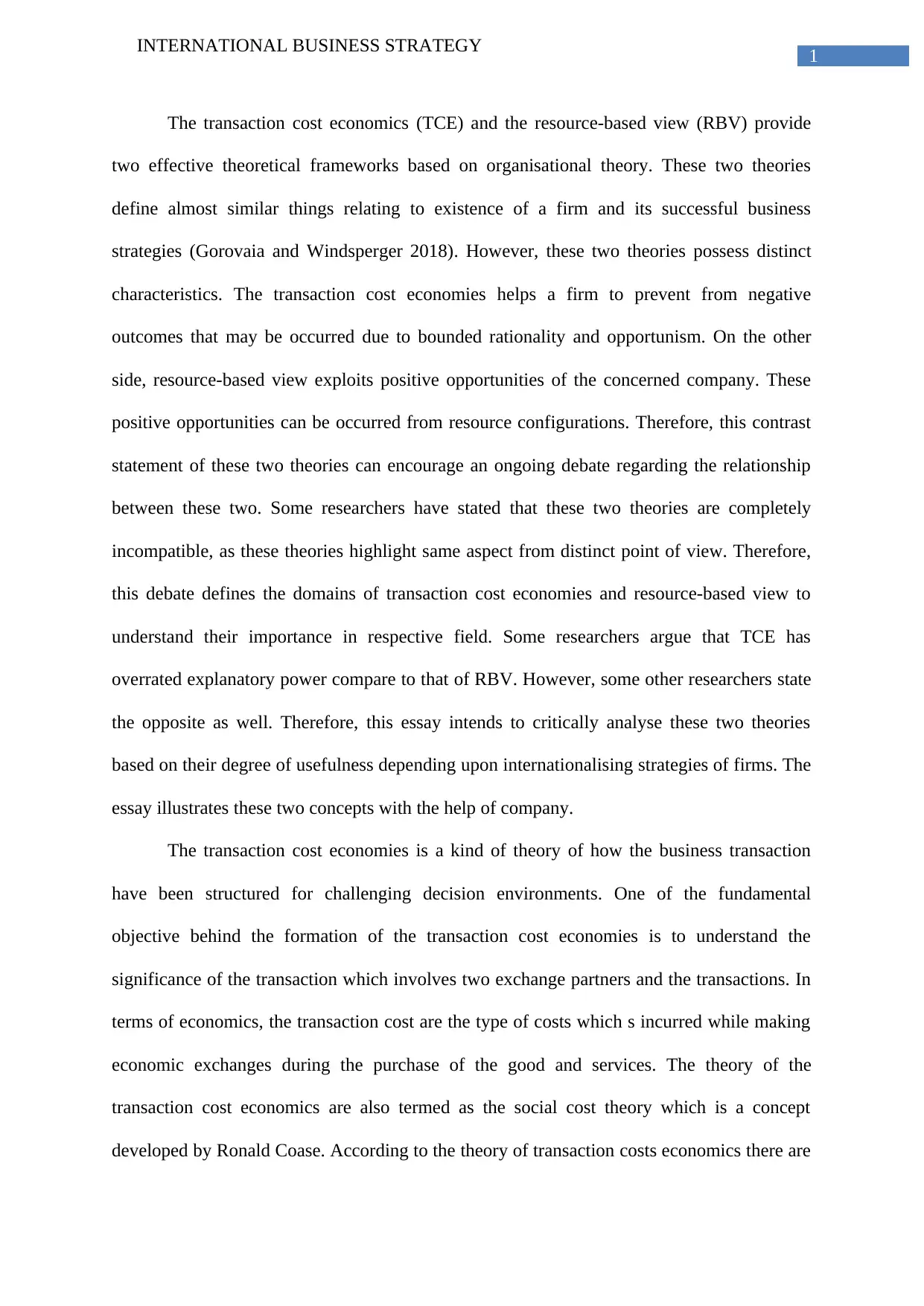
1
INTERNATIONAL BUSINESS STRATEGY
The transaction cost economics (TCE) and the resource-based view (RBV) provide
two effective theoretical frameworks based on organisational theory. These two theories
define almost similar things relating to existence of a firm and its successful business
strategies (Gorovaia and Windsperger 2018). However, these two theories possess distinct
characteristics. The transaction cost economies helps a firm to prevent from negative
outcomes that may be occurred due to bounded rationality and opportunism. On the other
side, resource-based view exploits positive opportunities of the concerned company. These
positive opportunities can be occurred from resource configurations. Therefore, this contrast
statement of these two theories can encourage an ongoing debate regarding the relationship
between these two. Some researchers have stated that these two theories are completely
incompatible, as these theories highlight same aspect from distinct point of view. Therefore,
this debate defines the domains of transaction cost economies and resource-based view to
understand their importance in respective field. Some researchers argue that TCE has
overrated explanatory power compare to that of RBV. However, some other researchers state
the opposite as well. Therefore, this essay intends to critically analyse these two theories
based on their degree of usefulness depending upon internationalising strategies of firms. The
essay illustrates these two concepts with the help of company.
The transaction cost economies is a kind of theory of how the business transaction
have been structured for challenging decision environments. One of the fundamental
objective behind the formation of the transaction cost economies is to understand the
significance of the transaction which involves two exchange partners and the transactions. In
terms of economics, the transaction cost are the type of costs which s incurred while making
economic exchanges during the purchase of the good and services. The theory of the
transaction cost economics are also termed as the social cost theory which is a concept
developed by Ronald Coase. According to the theory of transaction costs economics there are
INTERNATIONAL BUSINESS STRATEGY
The transaction cost economics (TCE) and the resource-based view (RBV) provide
two effective theoretical frameworks based on organisational theory. These two theories
define almost similar things relating to existence of a firm and its successful business
strategies (Gorovaia and Windsperger 2018). However, these two theories possess distinct
characteristics. The transaction cost economies helps a firm to prevent from negative
outcomes that may be occurred due to bounded rationality and opportunism. On the other
side, resource-based view exploits positive opportunities of the concerned company. These
positive opportunities can be occurred from resource configurations. Therefore, this contrast
statement of these two theories can encourage an ongoing debate regarding the relationship
between these two. Some researchers have stated that these two theories are completely
incompatible, as these theories highlight same aspect from distinct point of view. Therefore,
this debate defines the domains of transaction cost economies and resource-based view to
understand their importance in respective field. Some researchers argue that TCE has
overrated explanatory power compare to that of RBV. However, some other researchers state
the opposite as well. Therefore, this essay intends to critically analyse these two theories
based on their degree of usefulness depending upon internationalising strategies of firms. The
essay illustrates these two concepts with the help of company.
The transaction cost economies is a kind of theory of how the business transaction
have been structured for challenging decision environments. One of the fundamental
objective behind the formation of the transaction cost economies is to understand the
significance of the transaction which involves two exchange partners and the transactions. In
terms of economics, the transaction cost are the type of costs which s incurred while making
economic exchanges during the purchase of the good and services. The theory of the
transaction cost economics are also termed as the social cost theory which is a concept
developed by Ronald Coase. According to the theory of transaction costs economics there are
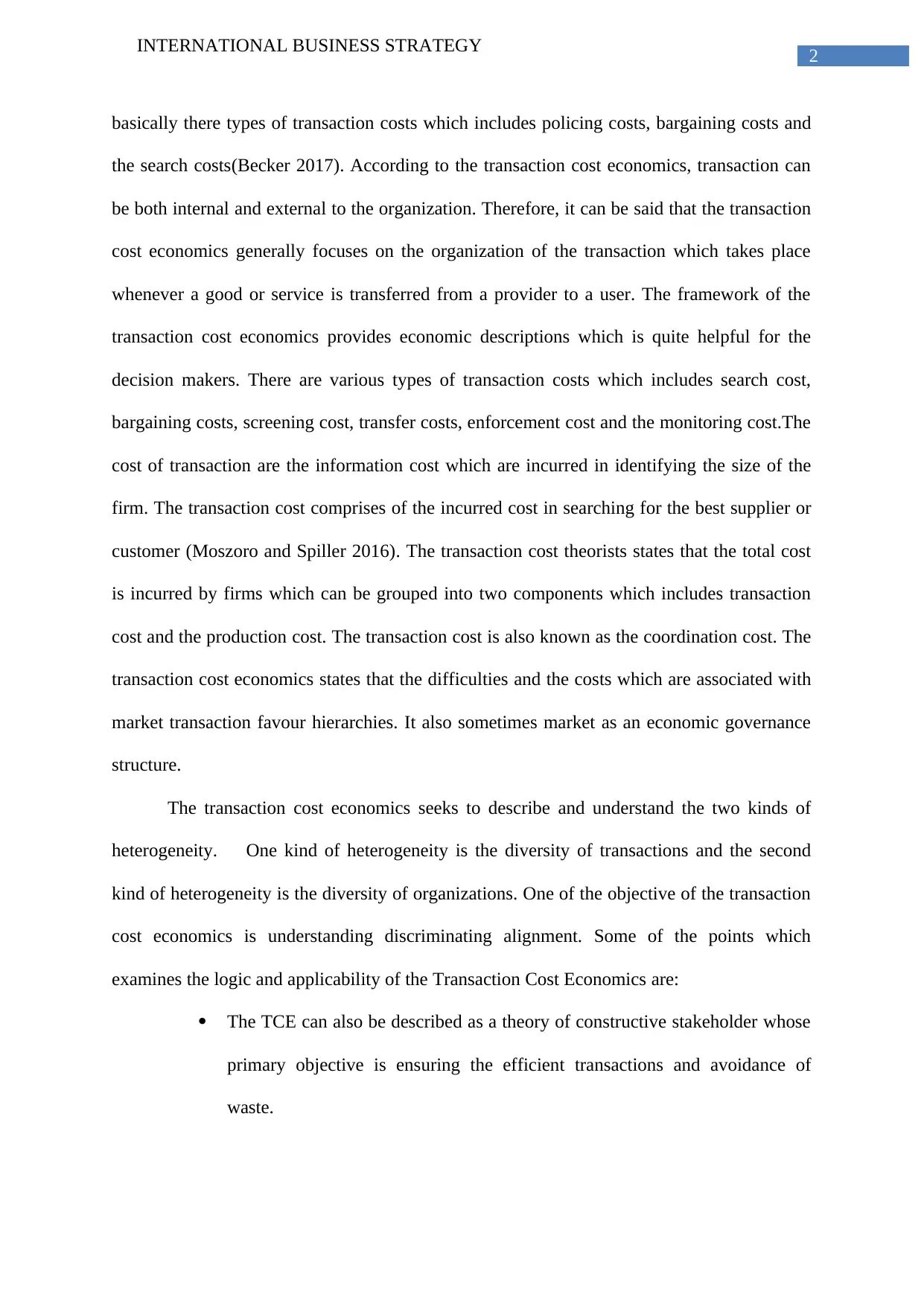
2
INTERNATIONAL BUSINESS STRATEGY
basically there types of transaction costs which includes policing costs, bargaining costs and
the search costs(Becker 2017). According to the transaction cost economics, transaction can
be both internal and external to the organization. Therefore, it can be said that the transaction
cost economics generally focuses on the organization of the transaction which takes place
whenever a good or service is transferred from a provider to a user. The framework of the
transaction cost economics provides economic descriptions which is quite helpful for the
decision makers. There are various types of transaction costs which includes search cost,
bargaining costs, screening cost, transfer costs, enforcement cost and the monitoring cost.The
cost of transaction are the information cost which are incurred in identifying the size of the
firm. The transaction cost comprises of the incurred cost in searching for the best supplier or
customer (Moszoro and Spiller 2016). The transaction cost theorists states that the total cost
is incurred by firms which can be grouped into two components which includes transaction
cost and the production cost. The transaction cost is also known as the coordination cost. The
transaction cost economics states that the difficulties and the costs which are associated with
market transaction favour hierarchies. It also sometimes market as an economic governance
structure.
The transaction cost economics seeks to describe and understand the two kinds of
heterogeneity. One kind of heterogeneity is the diversity of transactions and the second
kind of heterogeneity is the diversity of organizations. One of the objective of the transaction
cost economics is understanding discriminating alignment. Some of the points which
examines the logic and applicability of the Transaction Cost Economics are:
The TCE can also be described as a theory of constructive stakeholder whose
primary objective is ensuring the efficient transactions and avoidance of
waste.
INTERNATIONAL BUSINESS STRATEGY
basically there types of transaction costs which includes policing costs, bargaining costs and
the search costs(Becker 2017). According to the transaction cost economics, transaction can
be both internal and external to the organization. Therefore, it can be said that the transaction
cost economics generally focuses on the organization of the transaction which takes place
whenever a good or service is transferred from a provider to a user. The framework of the
transaction cost economics provides economic descriptions which is quite helpful for the
decision makers. There are various types of transaction costs which includes search cost,
bargaining costs, screening cost, transfer costs, enforcement cost and the monitoring cost.The
cost of transaction are the information cost which are incurred in identifying the size of the
firm. The transaction cost comprises of the incurred cost in searching for the best supplier or
customer (Moszoro and Spiller 2016). The transaction cost theorists states that the total cost
is incurred by firms which can be grouped into two components which includes transaction
cost and the production cost. The transaction cost is also known as the coordination cost. The
transaction cost economics states that the difficulties and the costs which are associated with
market transaction favour hierarchies. It also sometimes market as an economic governance
structure.
The transaction cost economics seeks to describe and understand the two kinds of
heterogeneity. One kind of heterogeneity is the diversity of transactions and the second
kind of heterogeneity is the diversity of organizations. One of the objective of the transaction
cost economics is understanding discriminating alignment. Some of the points which
examines the logic and applicability of the Transaction Cost Economics are:
The TCE can also be described as a theory of constructive stakeholder whose
primary objective is ensuring the efficient transactions and avoidance of
waste.
⊘ This is a preview!⊘
Do you want full access?
Subscribe today to unlock all pages.

Trusted by 1+ million students worldwide
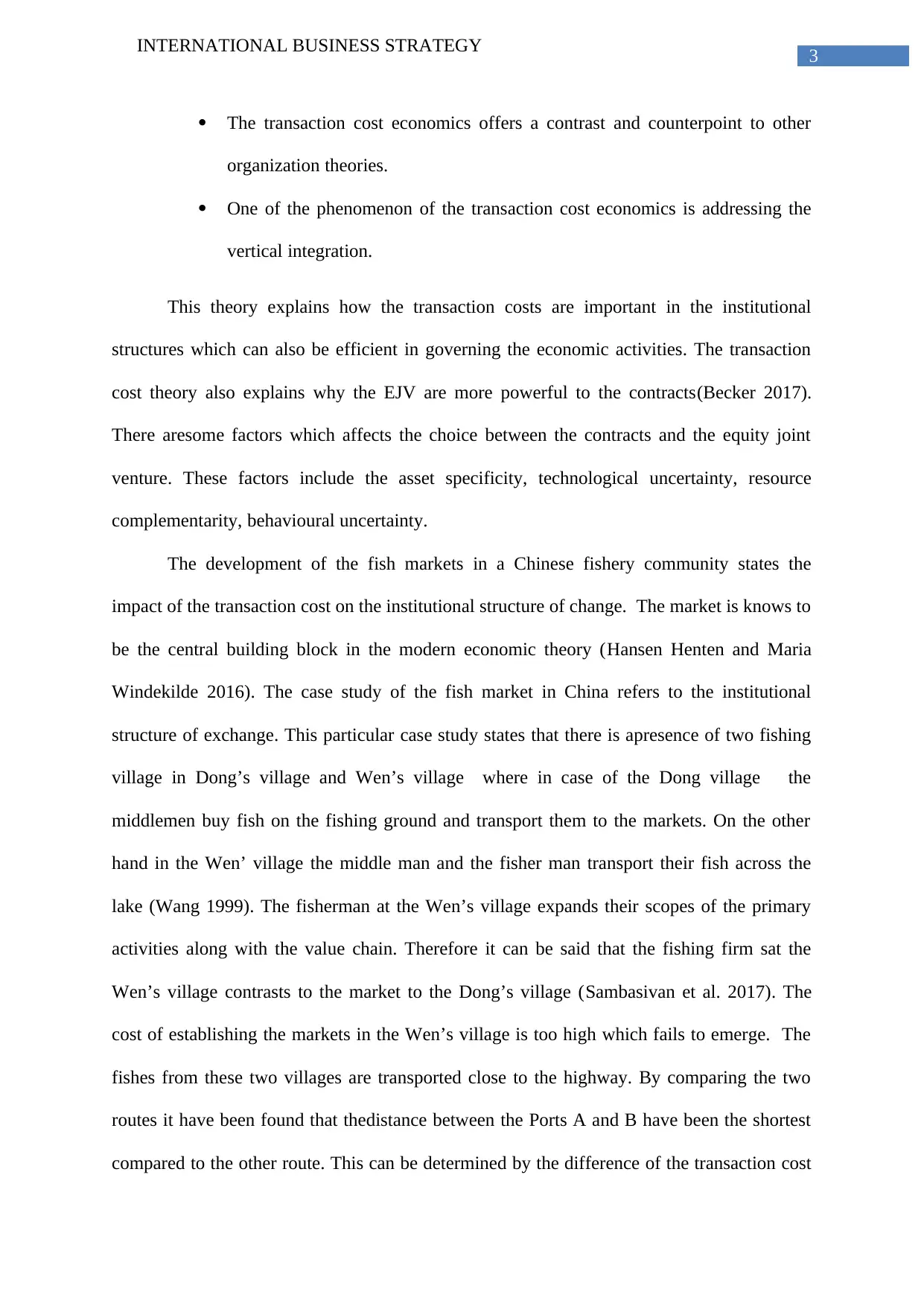
3
INTERNATIONAL BUSINESS STRATEGY
The transaction cost economics offers a contrast and counterpoint to other
organization theories.
One of the phenomenon of the transaction cost economics is addressing the
vertical integration.
This theory explains how the transaction costs are important in the institutional
structures which can also be efficient in governing the economic activities. The transaction
cost theory also explains why the EJV are more powerful to the contracts(Becker 2017).
There aresome factors which affects the choice between the contracts and the equity joint
venture. These factors include the asset specificity, technological uncertainty, resource
complementarity, behavioural uncertainty.
The development of the fish markets in a Chinese fishery community states the
impact of the transaction cost on the institutional structure of change. The market is knows to
be the central building block in the modern economic theory (Hansen Henten and Maria
Windekilde 2016). The case study of the fish market in China refers to the institutional
structure of exchange. This particular case study states that there is apresence of two fishing
village in Dong’s village and Wen’s village where in case of the Dong village the
middlemen buy fish on the fishing ground and transport them to the markets. On the other
hand in the Wen’ village the middle man and the fisher man transport their fish across the
lake (Wang 1999). The fisherman at the Wen’s village expands their scopes of the primary
activities along with the value chain. Therefore it can be said that the fishing firm sat the
Wen’s village contrasts to the market to the Dong’s village (Sambasivan et al. 2017). The
cost of establishing the markets in the Wen’s village is too high which fails to emerge. The
fishes from these two villages are transported close to the highway. By comparing the two
routes it have been found that thedistance between the Ports A and B have been the shortest
compared to the other route. This can be determined by the difference of the transaction cost
INTERNATIONAL BUSINESS STRATEGY
The transaction cost economics offers a contrast and counterpoint to other
organization theories.
One of the phenomenon of the transaction cost economics is addressing the
vertical integration.
This theory explains how the transaction costs are important in the institutional
structures which can also be efficient in governing the economic activities. The transaction
cost theory also explains why the EJV are more powerful to the contracts(Becker 2017).
There aresome factors which affects the choice between the contracts and the equity joint
venture. These factors include the asset specificity, technological uncertainty, resource
complementarity, behavioural uncertainty.
The development of the fish markets in a Chinese fishery community states the
impact of the transaction cost on the institutional structure of change. The market is knows to
be the central building block in the modern economic theory (Hansen Henten and Maria
Windekilde 2016). The case study of the fish market in China refers to the institutional
structure of exchange. This particular case study states that there is apresence of two fishing
village in Dong’s village and Wen’s village where in case of the Dong village the
middlemen buy fish on the fishing ground and transport them to the markets. On the other
hand in the Wen’ village the middle man and the fisher man transport their fish across the
lake (Wang 1999). The fisherman at the Wen’s village expands their scopes of the primary
activities along with the value chain. Therefore it can be said that the fishing firm sat the
Wen’s village contrasts to the market to the Dong’s village (Sambasivan et al. 2017). The
cost of establishing the markets in the Wen’s village is too high which fails to emerge. The
fishes from these two villages are transported close to the highway. By comparing the two
routes it have been found that thedistance between the Ports A and B have been the shortest
compared to the other route. This can be determined by the difference of the transaction cost
Paraphrase This Document
Need a fresh take? Get an instant paraphrase of this document with our AI Paraphraser
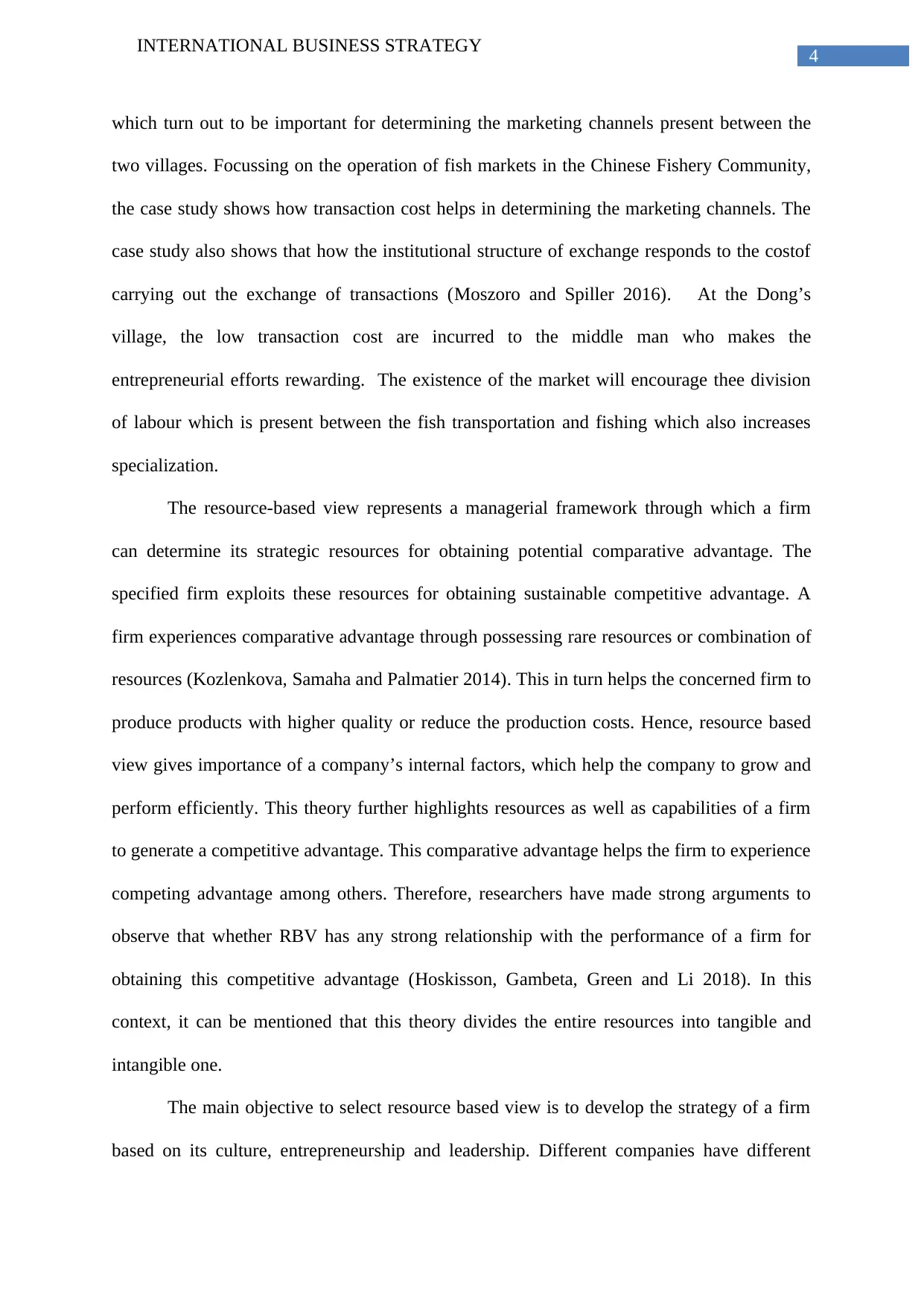
4
INTERNATIONAL BUSINESS STRATEGY
which turn out to be important for determining the marketing channels present between the
two villages. Focussing on the operation of fish markets in the Chinese Fishery Community,
the case study shows how transaction cost helps in determining the marketing channels. The
case study also shows that how the institutional structure of exchange responds to the costof
carrying out the exchange of transactions (Moszoro and Spiller 2016). At the Dong’s
village, the low transaction cost are incurred to the middle man who makes the
entrepreneurial efforts rewarding. The existence of the market will encourage thee division
of labour which is present between the fish transportation and fishing which also increases
specialization.
The resource-based view represents a managerial framework through which a firm
can determine its strategic resources for obtaining potential comparative advantage. The
specified firm exploits these resources for obtaining sustainable competitive advantage. A
firm experiences comparative advantage through possessing rare resources or combination of
resources (Kozlenkova, Samaha and Palmatier 2014). This in turn helps the concerned firm to
produce products with higher quality or reduce the production costs. Hence, resource based
view gives importance of a company’s internal factors, which help the company to grow and
perform efficiently. This theory further highlights resources as well as capabilities of a firm
to generate a competitive advantage. This comparative advantage helps the firm to experience
competing advantage among others. Therefore, researchers have made strong arguments to
observe that whether RBV has any strong relationship with the performance of a firm for
obtaining this competitive advantage (Hoskisson, Gambeta, Green and Li 2018). In this
context, it can be mentioned that this theory divides the entire resources into tangible and
intangible one.
The main objective to select resource based view is to develop the strategy of a firm
based on its culture, entrepreneurship and leadership. Different companies have different
INTERNATIONAL BUSINESS STRATEGY
which turn out to be important for determining the marketing channels present between the
two villages. Focussing on the operation of fish markets in the Chinese Fishery Community,
the case study shows how transaction cost helps in determining the marketing channels. The
case study also shows that how the institutional structure of exchange responds to the costof
carrying out the exchange of transactions (Moszoro and Spiller 2016). At the Dong’s
village, the low transaction cost are incurred to the middle man who makes the
entrepreneurial efforts rewarding. The existence of the market will encourage thee division
of labour which is present between the fish transportation and fishing which also increases
specialization.
The resource-based view represents a managerial framework through which a firm
can determine its strategic resources for obtaining potential comparative advantage. The
specified firm exploits these resources for obtaining sustainable competitive advantage. A
firm experiences comparative advantage through possessing rare resources or combination of
resources (Kozlenkova, Samaha and Palmatier 2014). This in turn helps the concerned firm to
produce products with higher quality or reduce the production costs. Hence, resource based
view gives importance of a company’s internal factors, which help the company to grow and
perform efficiently. This theory further highlights resources as well as capabilities of a firm
to generate a competitive advantage. This comparative advantage helps the firm to experience
competing advantage among others. Therefore, researchers have made strong arguments to
observe that whether RBV has any strong relationship with the performance of a firm for
obtaining this competitive advantage (Hoskisson, Gambeta, Green and Li 2018). In this
context, it can be mentioned that this theory divides the entire resources into tangible and
intangible one.
The main objective to select resource based view is to develop the strategy of a firm
based on its culture, entrepreneurship and leadership. Different companies have different
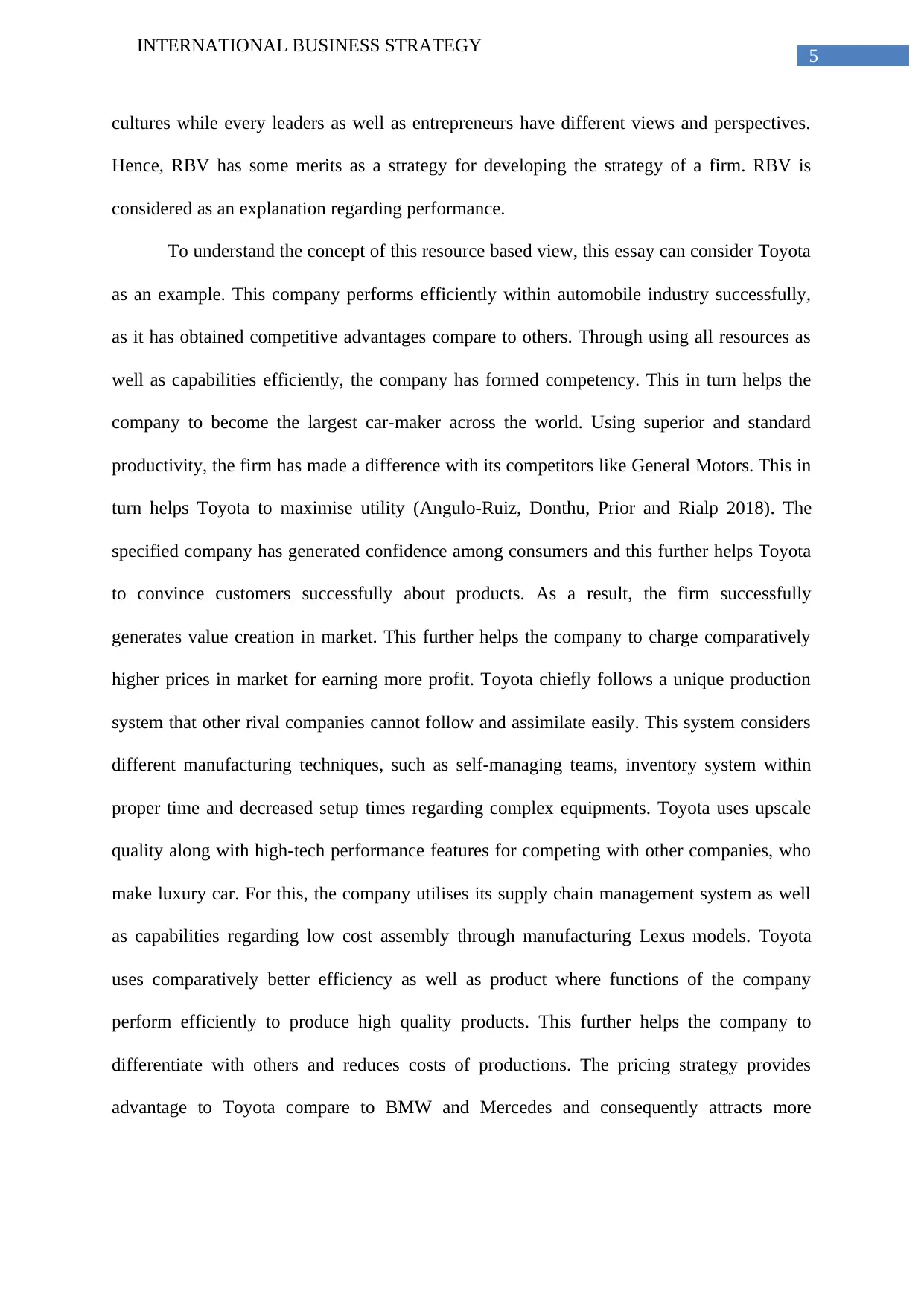
5
INTERNATIONAL BUSINESS STRATEGY
cultures while every leaders as well as entrepreneurs have different views and perspectives.
Hence, RBV has some merits as a strategy for developing the strategy of a firm. RBV is
considered as an explanation regarding performance.
To understand the concept of this resource based view, this essay can consider Toyota
as an example. This company performs efficiently within automobile industry successfully,
as it has obtained competitive advantages compare to others. Through using all resources as
well as capabilities efficiently, the company has formed competency. This in turn helps the
company to become the largest car-maker across the world. Using superior and standard
productivity, the firm has made a difference with its competitors like General Motors. This in
turn helps Toyota to maximise utility (Angulo-Ruiz, Donthu, Prior and Rialp 2018). The
specified company has generated confidence among consumers and this further helps Toyota
to convince customers successfully about products. As a result, the firm successfully
generates value creation in market. This further helps the company to charge comparatively
higher prices in market for earning more profit. Toyota chiefly follows a unique production
system that other rival companies cannot follow and assimilate easily. This system considers
different manufacturing techniques, such as self-managing teams, inventory system within
proper time and decreased setup times regarding complex equipments. Toyota uses upscale
quality along with high-tech performance features for competing with other companies, who
make luxury car. For this, the company utilises its supply chain management system as well
as capabilities regarding low cost assembly through manufacturing Lexus models. Toyota
uses comparatively better efficiency as well as product where functions of the company
perform efficiently to produce high quality products. This further helps the company to
differentiate with others and reduces costs of productions. The pricing strategy provides
advantage to Toyota compare to BMW and Mercedes and consequently attracts more
INTERNATIONAL BUSINESS STRATEGY
cultures while every leaders as well as entrepreneurs have different views and perspectives.
Hence, RBV has some merits as a strategy for developing the strategy of a firm. RBV is
considered as an explanation regarding performance.
To understand the concept of this resource based view, this essay can consider Toyota
as an example. This company performs efficiently within automobile industry successfully,
as it has obtained competitive advantages compare to others. Through using all resources as
well as capabilities efficiently, the company has formed competency. This in turn helps the
company to become the largest car-maker across the world. Using superior and standard
productivity, the firm has made a difference with its competitors like General Motors. This in
turn helps Toyota to maximise utility (Angulo-Ruiz, Donthu, Prior and Rialp 2018). The
specified company has generated confidence among consumers and this further helps Toyota
to convince customers successfully about products. As a result, the firm successfully
generates value creation in market. This further helps the company to charge comparatively
higher prices in market for earning more profit. Toyota chiefly follows a unique production
system that other rival companies cannot follow and assimilate easily. This system considers
different manufacturing techniques, such as self-managing teams, inventory system within
proper time and decreased setup times regarding complex equipments. Toyota uses upscale
quality along with high-tech performance features for competing with other companies, who
make luxury car. For this, the company utilises its supply chain management system as well
as capabilities regarding low cost assembly through manufacturing Lexus models. Toyota
uses comparatively better efficiency as well as product where functions of the company
perform efficiently to produce high quality products. This further helps the company to
differentiate with others and reduces costs of productions. The pricing strategy provides
advantage to Toyota compare to BMW and Mercedes and consequently attracts more
⊘ This is a preview!⊘
Do you want full access?
Subscribe today to unlock all pages.

Trusted by 1+ million students worldwide
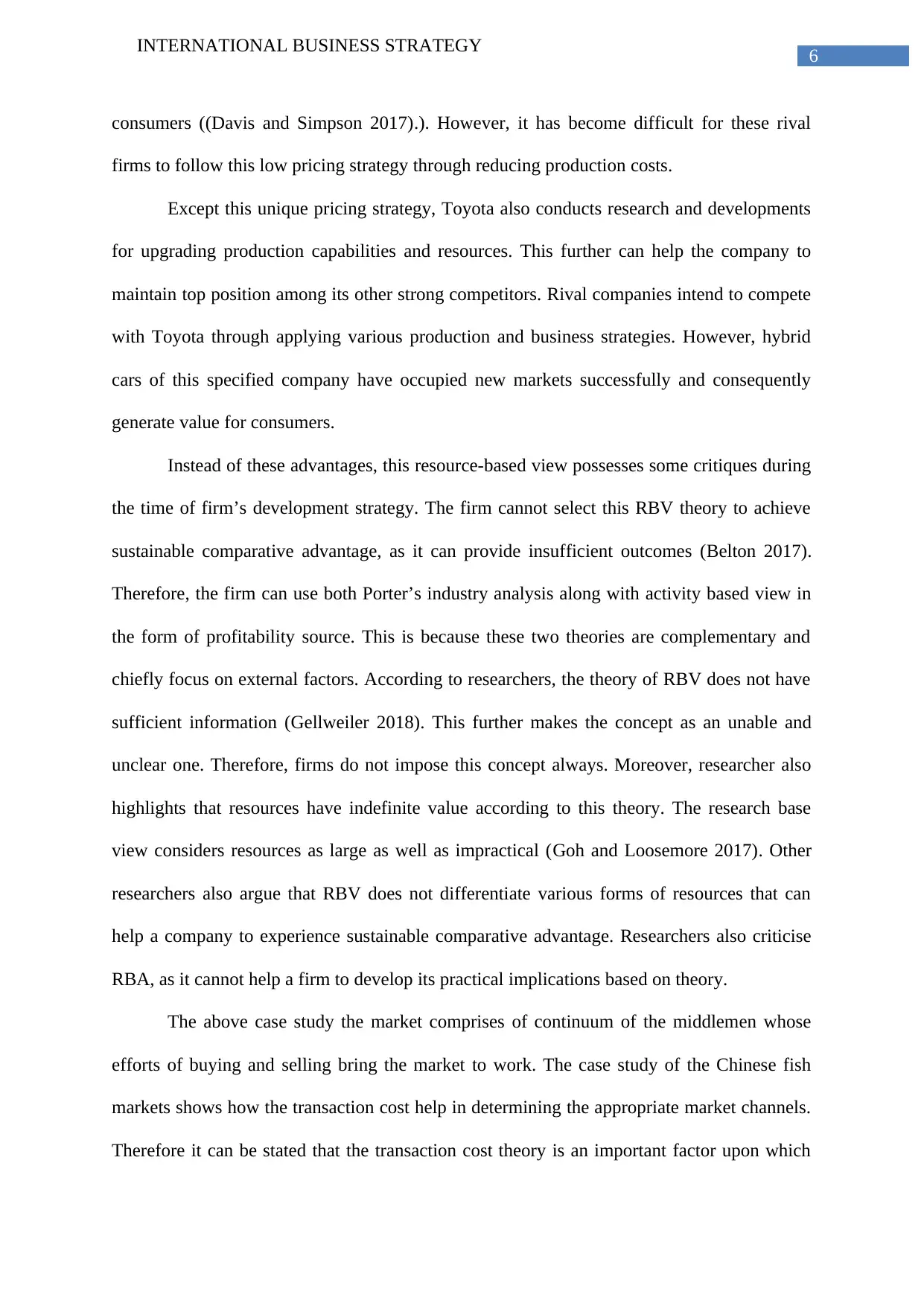
6
INTERNATIONAL BUSINESS STRATEGY
consumers ((Davis and Simpson 2017).). However, it has become difficult for these rival
firms to follow this low pricing strategy through reducing production costs.
Except this unique pricing strategy, Toyota also conducts research and developments
for upgrading production capabilities and resources. This further can help the company to
maintain top position among its other strong competitors. Rival companies intend to compete
with Toyota through applying various production and business strategies. However, hybrid
cars of this specified company have occupied new markets successfully and consequently
generate value for consumers.
Instead of these advantages, this resource-based view possesses some critiques during
the time of firm’s development strategy. The firm cannot select this RBV theory to achieve
sustainable comparative advantage, as it can provide insufficient outcomes (Belton 2017).
Therefore, the firm can use both Porter’s industry analysis along with activity based view in
the form of profitability source. This is because these two theories are complementary and
chiefly focus on external factors. According to researchers, the theory of RBV does not have
sufficient information (Gellweiler 2018). This further makes the concept as an unable and
unclear one. Therefore, firms do not impose this concept always. Moreover, researcher also
highlights that resources have indefinite value according to this theory. The research base
view considers resources as large as well as impractical (Goh and Loosemore 2017). Other
researchers also argue that RBV does not differentiate various forms of resources that can
help a company to experience sustainable comparative advantage. Researchers also criticise
RBA, as it cannot help a firm to develop its practical implications based on theory.
The above case study the market comprises of continuum of the middlemen whose
efforts of buying and selling bring the market to work. The case study of the Chinese fish
markets shows how the transaction cost help in determining the appropriate market channels.
Therefore it can be stated that the transaction cost theory is an important factor upon which
INTERNATIONAL BUSINESS STRATEGY
consumers ((Davis and Simpson 2017).). However, it has become difficult for these rival
firms to follow this low pricing strategy through reducing production costs.
Except this unique pricing strategy, Toyota also conducts research and developments
for upgrading production capabilities and resources. This further can help the company to
maintain top position among its other strong competitors. Rival companies intend to compete
with Toyota through applying various production and business strategies. However, hybrid
cars of this specified company have occupied new markets successfully and consequently
generate value for consumers.
Instead of these advantages, this resource-based view possesses some critiques during
the time of firm’s development strategy. The firm cannot select this RBV theory to achieve
sustainable comparative advantage, as it can provide insufficient outcomes (Belton 2017).
Therefore, the firm can use both Porter’s industry analysis along with activity based view in
the form of profitability source. This is because these two theories are complementary and
chiefly focus on external factors. According to researchers, the theory of RBV does not have
sufficient information (Gellweiler 2018). This further makes the concept as an unable and
unclear one. Therefore, firms do not impose this concept always. Moreover, researcher also
highlights that resources have indefinite value according to this theory. The research base
view considers resources as large as well as impractical (Goh and Loosemore 2017). Other
researchers also argue that RBV does not differentiate various forms of resources that can
help a company to experience sustainable comparative advantage. Researchers also criticise
RBA, as it cannot help a firm to develop its practical implications based on theory.
The above case study the market comprises of continuum of the middlemen whose
efforts of buying and selling bring the market to work. The case study of the Chinese fish
markets shows how the transaction cost help in determining the appropriate market channels.
Therefore it can be stated that the transaction cost theory is an important factor upon which
Paraphrase This Document
Need a fresh take? Get an instant paraphrase of this document with our AI Paraphraser
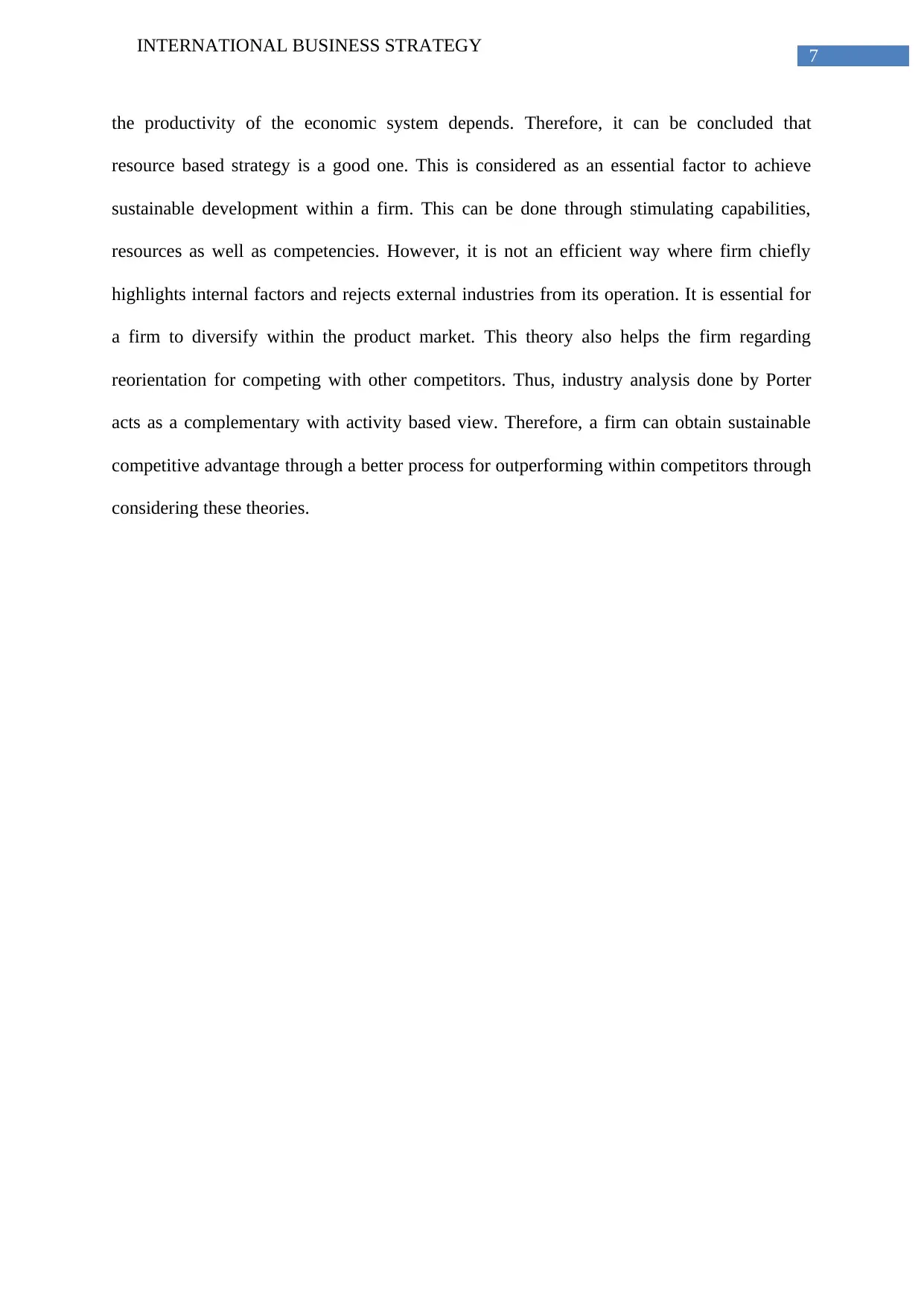
7
INTERNATIONAL BUSINESS STRATEGY
the productivity of the economic system depends. Therefore, it can be concluded that
resource based strategy is a good one. This is considered as an essential factor to achieve
sustainable development within a firm. This can be done through stimulating capabilities,
resources as well as competencies. However, it is not an efficient way where firm chiefly
highlights internal factors and rejects external industries from its operation. It is essential for
a firm to diversify within the product market. This theory also helps the firm regarding
reorientation for competing with other competitors. Thus, industry analysis done by Porter
acts as a complementary with activity based view. Therefore, a firm can obtain sustainable
competitive advantage through a better process for outperforming within competitors through
considering these theories.
INTERNATIONAL BUSINESS STRATEGY
the productivity of the economic system depends. Therefore, it can be concluded that
resource based strategy is a good one. This is considered as an essential factor to achieve
sustainable development within a firm. This can be done through stimulating capabilities,
resources as well as competencies. However, it is not an efficient way where firm chiefly
highlights internal factors and rejects external industries from its operation. It is essential for
a firm to diversify within the product market. This theory also helps the firm regarding
reorientation for competing with other competitors. Thus, industry analysis done by Porter
acts as a complementary with activity based view. Therefore, a firm can obtain sustainable
competitive advantage through a better process for outperforming within competitors through
considering these theories.
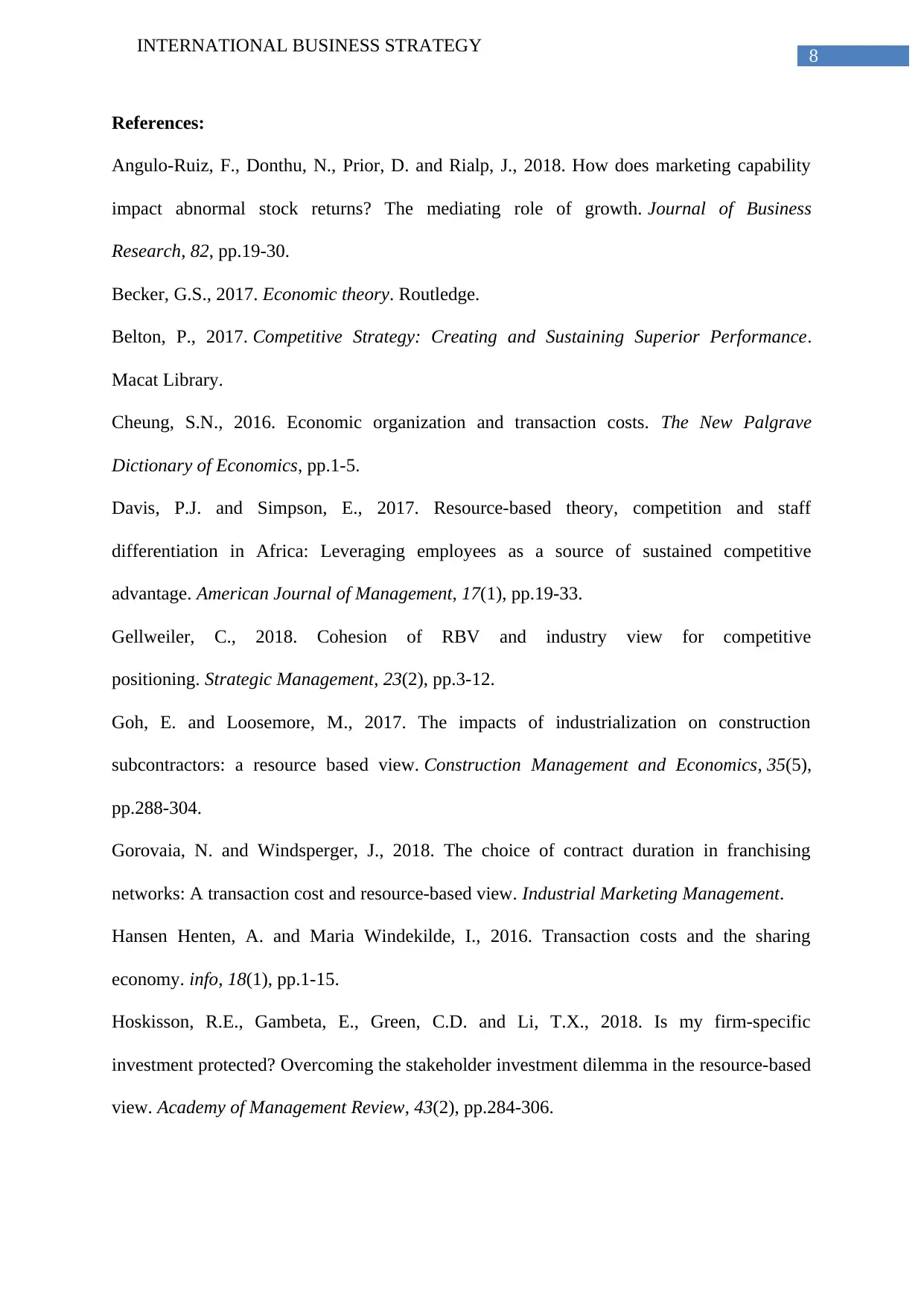
8
INTERNATIONAL BUSINESS STRATEGY
References:
Angulo-Ruiz, F., Donthu, N., Prior, D. and Rialp, J., 2018. How does marketing capability
impact abnormal stock returns? The mediating role of growth. Journal of Business
Research, 82, pp.19-30.
Becker, G.S., 2017. Economic theory. Routledge.
Belton, P., 2017. Competitive Strategy: Creating and Sustaining Superior Performance.
Macat Library.
Cheung, S.N., 2016. Economic organization and transaction costs. The New Palgrave
Dictionary of Economics, pp.1-5.
Davis, P.J. and Simpson, E., 2017. Resource-based theory, competition and staff
differentiation in Africa: Leveraging employees as a source of sustained competitive
advantage. American Journal of Management, 17(1), pp.19-33.
Gellweiler, C., 2018. Cohesion of RBV and industry view for competitive
positioning. Strategic Management, 23(2), pp.3-12.
Goh, E. and Loosemore, M., 2017. The impacts of industrialization on construction
subcontractors: a resource based view. Construction Management and Economics, 35(5),
pp.288-304.
Gorovaia, N. and Windsperger, J., 2018. The choice of contract duration in franchising
networks: A transaction cost and resource-based view. Industrial Marketing Management.
Hansen Henten, A. and Maria Windekilde, I., 2016. Transaction costs and the sharing
economy. info, 18(1), pp.1-15.
Hoskisson, R.E., Gambeta, E., Green, C.D. and Li, T.X., 2018. Is my firm-specific
investment protected? Overcoming the stakeholder investment dilemma in the resource-based
view. Academy of Management Review, 43(2), pp.284-306.
INTERNATIONAL BUSINESS STRATEGY
References:
Angulo-Ruiz, F., Donthu, N., Prior, D. and Rialp, J., 2018. How does marketing capability
impact abnormal stock returns? The mediating role of growth. Journal of Business
Research, 82, pp.19-30.
Becker, G.S., 2017. Economic theory. Routledge.
Belton, P., 2017. Competitive Strategy: Creating and Sustaining Superior Performance.
Macat Library.
Cheung, S.N., 2016. Economic organization and transaction costs. The New Palgrave
Dictionary of Economics, pp.1-5.
Davis, P.J. and Simpson, E., 2017. Resource-based theory, competition and staff
differentiation in Africa: Leveraging employees as a source of sustained competitive
advantage. American Journal of Management, 17(1), pp.19-33.
Gellweiler, C., 2018. Cohesion of RBV and industry view for competitive
positioning. Strategic Management, 23(2), pp.3-12.
Goh, E. and Loosemore, M., 2017. The impacts of industrialization on construction
subcontractors: a resource based view. Construction Management and Economics, 35(5),
pp.288-304.
Gorovaia, N. and Windsperger, J., 2018. The choice of contract duration in franchising
networks: A transaction cost and resource-based view. Industrial Marketing Management.
Hansen Henten, A. and Maria Windekilde, I., 2016. Transaction costs and the sharing
economy. info, 18(1), pp.1-15.
Hoskisson, R.E., Gambeta, E., Green, C.D. and Li, T.X., 2018. Is my firm-specific
investment protected? Overcoming the stakeholder investment dilemma in the resource-based
view. Academy of Management Review, 43(2), pp.284-306.
⊘ This is a preview!⊘
Do you want full access?
Subscribe today to unlock all pages.

Trusted by 1+ million students worldwide
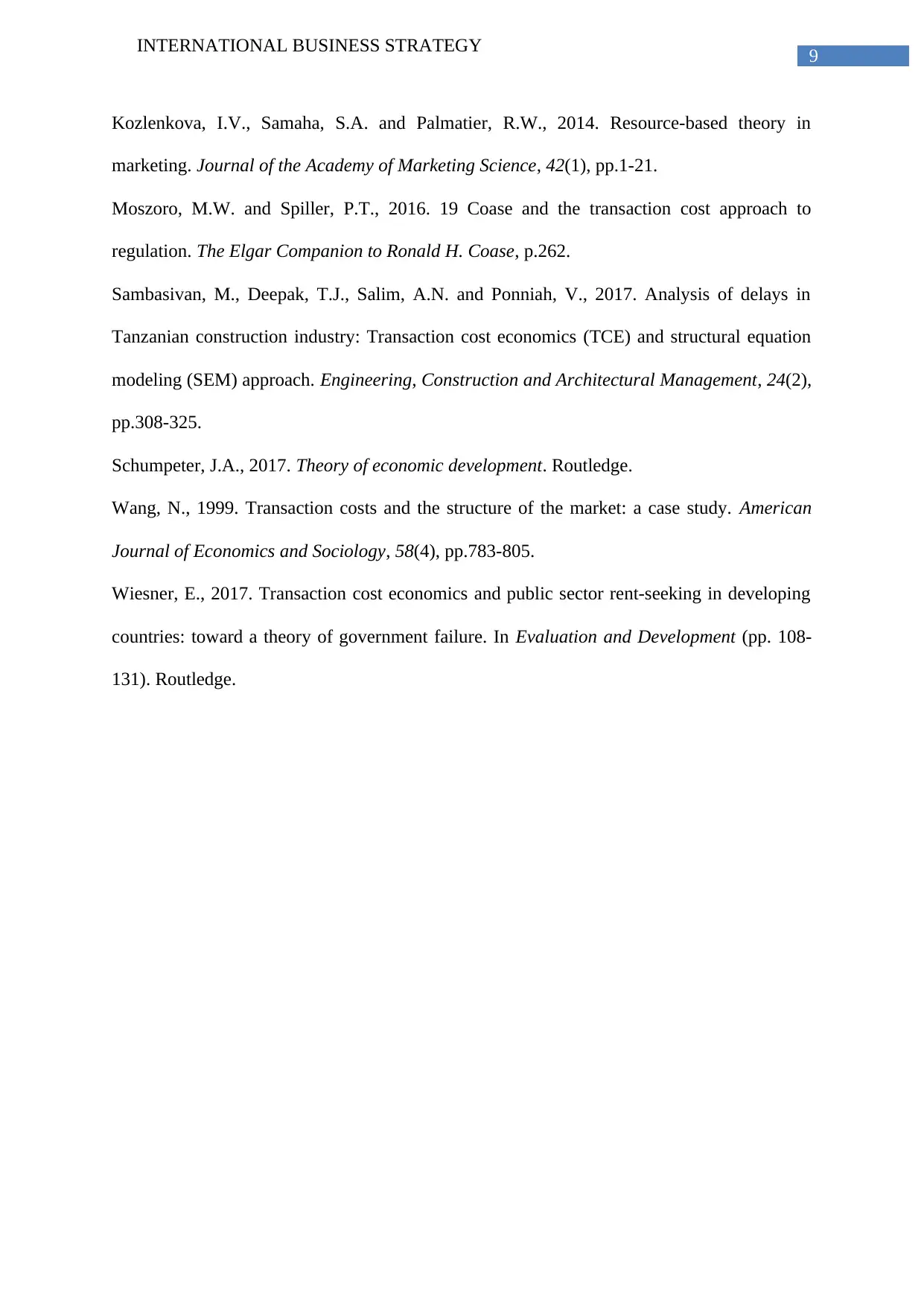
9
INTERNATIONAL BUSINESS STRATEGY
Kozlenkova, I.V., Samaha, S.A. and Palmatier, R.W., 2014. Resource-based theory in
marketing. Journal of the Academy of Marketing Science, 42(1), pp.1-21.
Moszoro, M.W. and Spiller, P.T., 2016. 19 Coase and the transaction cost approach to
regulation. The Elgar Companion to Ronald H. Coase, p.262.
Sambasivan, M., Deepak, T.J., Salim, A.N. and Ponniah, V., 2017. Analysis of delays in
Tanzanian construction industry: Transaction cost economics (TCE) and structural equation
modeling (SEM) approach. Engineering, Construction and Architectural Management, 24(2),
pp.308-325.
Schumpeter, J.A., 2017. Theory of economic development. Routledge.
Wang, N., 1999. Transaction costs and the structure of the market: a case study. American
Journal of Economics and Sociology, 58(4), pp.783-805.
Wiesner, E., 2017. Transaction cost economics and public sector rent-seeking in developing
countries: toward a theory of government failure. In Evaluation and Development (pp. 108-
131). Routledge.
INTERNATIONAL BUSINESS STRATEGY
Kozlenkova, I.V., Samaha, S.A. and Palmatier, R.W., 2014. Resource-based theory in
marketing. Journal of the Academy of Marketing Science, 42(1), pp.1-21.
Moszoro, M.W. and Spiller, P.T., 2016. 19 Coase and the transaction cost approach to
regulation. The Elgar Companion to Ronald H. Coase, p.262.
Sambasivan, M., Deepak, T.J., Salim, A.N. and Ponniah, V., 2017. Analysis of delays in
Tanzanian construction industry: Transaction cost economics (TCE) and structural equation
modeling (SEM) approach. Engineering, Construction and Architectural Management, 24(2),
pp.308-325.
Schumpeter, J.A., 2017. Theory of economic development. Routledge.
Wang, N., 1999. Transaction costs and the structure of the market: a case study. American
Journal of Economics and Sociology, 58(4), pp.783-805.
Wiesner, E., 2017. Transaction cost economics and public sector rent-seeking in developing
countries: toward a theory of government failure. In Evaluation and Development (pp. 108-
131). Routledge.
1 out of 10
Related Documents
Your All-in-One AI-Powered Toolkit for Academic Success.
+13062052269
info@desklib.com
Available 24*7 on WhatsApp / Email
![[object Object]](/_next/static/media/star-bottom.7253800d.svg)
Unlock your academic potential
Copyright © 2020–2025 A2Z Services. All Rights Reserved. Developed and managed by ZUCOL.





